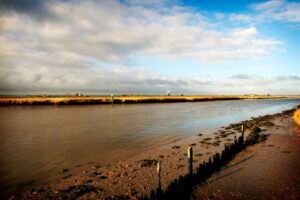Autumn on the Marshes
The Broads are one of the UK’s best year-round destinations. While many prefer to visit during the peak of summer, with warmer weather encouraging people out onto the water for a leisurely cruise, many unique opportunities only happen in the Autumn, when the air gets that wonderfully fresh and crisp quality, and when the warm reds and golds of sun cast long shadows across the marshes and the dry rustling reeds.
WMM Education Officer, Natasha Howard, tells us why she loves Autumn in the Broads..
“Autumn is my favourite time to be out in the Broads National Park; skeins of geese arrowing across the vast blue sky, the flowering ivy attracting bees in their thousands, the trees and bushes weighed down with nuts and fruits and somehow the landscape feels calmer after the frenzy of summer. But for me it’s the light that really makes autumn special. Mornings and evenings with the sun low on the horizon the myriad shades of brown from the reeds, falling leaves and bare trees are transformed into gleaming gold, bronze, copper and honey. To this burning background add bright splashes of crimson from the hips and haws and green from summer’s last remaining leaves. A photographer’s paradise. Yes the nights are getting longer, but it also means dawn isn’t crazy early, so there’s no need to lose precious hours of sleep or stay out long into the night, to catch sight of an otter bringing a writhing eel to shore or have bats flitting about your head while watching the silent flight of hunting barn owls.”

A Changing Landscape
Water dominates the Broads and as we get closer to winter and further from the warm and evaporative effects of the summer sunshine. The rain and tides play an important part in keeping this biologically important wetland… well wet! When you are out in the Broads over the Autumn you will notice how much more water there is on the surface, and how the wildlife has adapted to using all of this excess in a range of different habitats including rivers, ditches and dykes, marshes, mudflats and reedbeds. Just as these habitats are dynamic and always changing with the seasons, so is the wildlife that inhabit them.
For some, the arrival of Autumn means slowing down and preserving energy, this may involve losing leaves or slowing growth. It also sees the departure of many of our summer migrants, repeating their impressive migrations back home. For many others, this time of year is not all about loss and quieting down, many species are busy with preparations to hibernate, performing impressive aerial displays and a time of new arrivals.

Autumn Arrivals
Autumn signals the impressive migration of our winter migrants from their nesting grounds in the arctic to our wetlands and begin to get busy with wildfowl and wading birds. They leave the very cold and barren tundra, travelling huge distances and appearing in vast numbers seeking food rich wetlands. They will spend the winter on our coastlines, estuaries and mudflats which provide perfect spots to land, feed and take shelter where they are safe from most ground predators.
Each year, around 300,000 Oyster catchers, 50,000 Redshank and over half a million Lapwings arrive from Northern Europe, Iceland and Norway and can often be seen in large flocks to feed here. They are best viewed at low tide at sunrise or sunset, this is when they are more active and jostling for space to feed on invertebrates in the mud. This low sunlight can provide the most glorious photographs.
Breydon water is a hotspot to see wintering wading birds. Numbers can reach up to 100,000 in winter and usually made up of around 25,000 lapwing, 25,000 wigeon, 15,000 pink-footed geese and 30,000 golden plovers plus many more species including Teal and Snipe.

The Skies Above
Look up into the skies above the mudflats and marshes, which are still teaming with life. Autumn can be a good time to see birds of prey, shorter daylight hours make dusk and dawn feeding times at more sociable hours increasing the likelihood of spotting owls and raptors. Peregrine falcons and Merlins, take advantage of the flocking waders and water birds arriving at favoured wetland habitats, such as Breydon Water, and can be seen hunting in the open. Marsh Harriers also come together in large numbers to roost in the marshes and can be a fantastic sight. Another impressive sight is the large flocks of starling forming fantastic shapes in their murmurations as they also begin to roost in the Autumn.

Tracks in The Mud
As the leaves fall and the trees become bare this makes a good time to spot other mammals as there is less shelter to hide in. Look out for Chinese water deer, Hares or even Otters. If you don’t manage to see them in person, why not look for their tracks. With rain and wet, comes mud.. not always welcome on your boots but look closely and you will see lots of tracks in the mud. Use this helpful animal track ID sheet from the RSPB to help you identify who or what has been through where you are stood.
Time for a Walk
What better way to experience the Broads than by foot. There are miles and miles of gorgeous and breath taking scenery found across the Broads. From vast expanses of land with open skies to hidden trails leading to secluded bird hides, there is something for everyone looking for a day out to experience this unique landscape. Looking for inspiration of where to go? Check out our Top 5 Autumn Walks.
